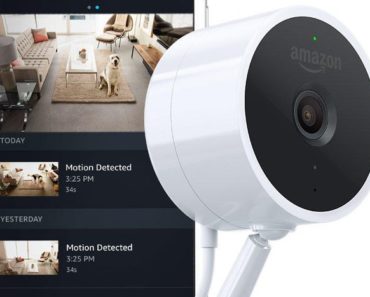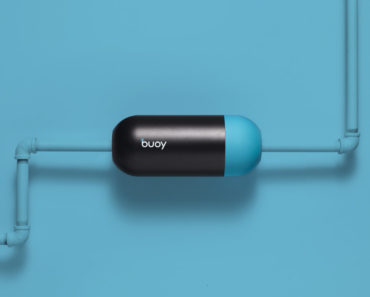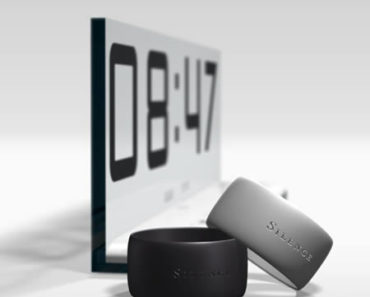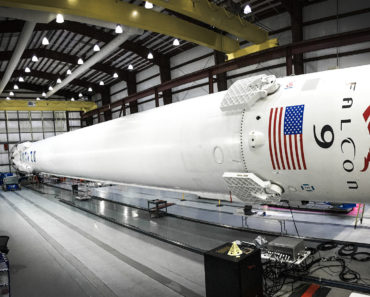When Phil Parker visits hospitals around the country, he brings Boo Boo along with him.
Boo Boo is great with kids. He plays Simon Says, reads books and plays music. He’s a good listener, and he can help calm a child’s nerves before they go into a procedure.
Boo Boo is not a medical professional, or even human. He’s a robot.
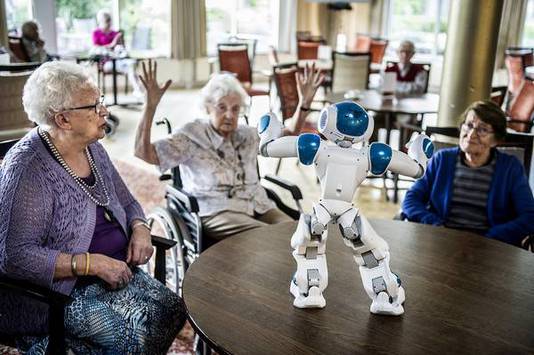
Robots like this one could help make a child’s hospital stay less stressful, and a senior care resident’s experience less lonely.
Robots like this one could help make a child’s hospital stay less stressful, and a senior care resident’s experience less lonely.
Standing at just under two feet tall, the red-and-white humanoid is a product, the Nao, from Softbank Robotics. He has a somewhat childlike appearance, with black, circular eyes that peer straight at you from his round head. Parker, a health care executive, named his robot Boo Boo to better fit the mission of helping injured and sick kids deal with the stress of being at the hospital.
Coupled with a software program from Belgian company ZoraBots, Boo Boo can play games or lead patients young and old through their exercises. Health care professionals don’t have to know how to code to work the Zora program. They can just drag boxes with commands in the order they want on a computer or tablet. The more technically adventurous can also write their own programs, as Parker often does.
Robots are entering a variety of industries, from security to retail. But Boo Boo is an example of how robots might be good for more than just replacing manual human labor: They could also serve as valuable companions for the lonely or ill. They’re even helping to relieve symptoms of depression and anxiety. Their 24/7 availability and undying patience rival what most humans can provide.
“He brings a joy and a distraction from either the pain or the sadness or the illness that humans just aren’t able to deliver to kids, even with our best attempts,” Parker said.
For young and old
ZoraBots is a worldwide distributor of the Nao robot, which it rebrands as Zora after adding custom touches with its own software. CEO Tommy Deblieck said when he and co-founder Fabrice Goffin started the company in 2012, the idea was to motivate recovering kids to do their exercises.
It’s worked out well for Parker. “Boo Boo will say, ‘Do what I do,’ and as soon as he does it, they do it, too,” he said.
“[Boo Boo] brings a joy and a distraction from either the pain or the sadness or the illness that humans just aren’t able to deliver to kids.”
Deblieck and Goffin expanded into an elder care center in Belgium, where the robot served as a physical therapist, showing patients how to move. Meanwhile, a human physical therapist was free to walk around and help people do the exercises correctly.
“We’ve done tests before with a screen or even the robot on a screen, and nobody cared,” Deblieck said. “But from the moment the Zora solution came in, you saw people starting to move.”
Perhaps the most important way Zora can help is through its very presence.
“Just having a robot around who is always there copes with loneliness,” Deblieck said.
He compares the excitement the robot brings in an elder care center to when children visit. For a short time, residents can let go of their worries and pain and just have a little fun.
Bot companion
Instead of using facial recognition, Zora works by scanning badges with QR codes to know who someone is. Deblieck says facial recognition can’t yet guarantee 100 percent accuracy, which is especially important in a hospital setting. So when a health care professional programs a set of exercises, that’s linked to a desired QR code.
Beyond the tech, kids just see a friendly companion. Parker said they interact with Boo Boo as if he’s one of them.
“They actually feel like he’s a friend of their age, and that’s how they describe it,” Parker said. “They’ll say, ‘Boo Boo knows what it feels like to get his blood drawn.'”
That kind of empathy can be helpful beyond a hospital setting. Maja Mataric, founding director of the Robotics and Autonomous Systems Center at the University of Southern California, is developing robot-assisted therapies for kids with autism spectrum disorders in an effort to boost their socialization skills.
She says robots can often elicit behaviors that a child doesn’t exhibit with other people: smiling, initiating play and talking more, for example. Children will also say empathetic things that they wouldn’t otherwise.
“They will say to the robot, ‘Do such and such,’ and the robot doesn’t because it can only do what it’s programmed to do,” Mataric said. “And then the child will say, ‘Oh, I know how my teacher feels now when I don’t do what she says.'”
The USC lab focuses on creating software for these socially assistive robots, or robots that help people through social rather than physical means. She’s also developing robot-assisted therapies for survivors of stroke and traumatic brain injury, as well as people with Alzheimer’s. The robots could provide them with 24/7 care.
Mataric launched a startup called Embodied almost two years ago to begin commercializing these technologies.
The software from her lab is also being studied in a hospital setting. Dr. Margaret Trost, a pediatric physician at Children’s Hospital Los Angeles and assistant professor of clinical pediatrics at USC’s Keck School of Medicine, is working with one of Mataric’s graduate students to bring socially assistive robots to CHLA.
“Although we make a ton of effort to make children’s hospitals a lot of fun, kids who are in the hospital a lot have to go through a lot of trauma,” Trost said.
She’s particularly interested in using Maki, a 3D-printed robot from Hello Robo that can be programmed to talk and play games, to reduce the pain associated with IV placement.
“There’s certainly a positive impact of having the robot over not having the robot.”
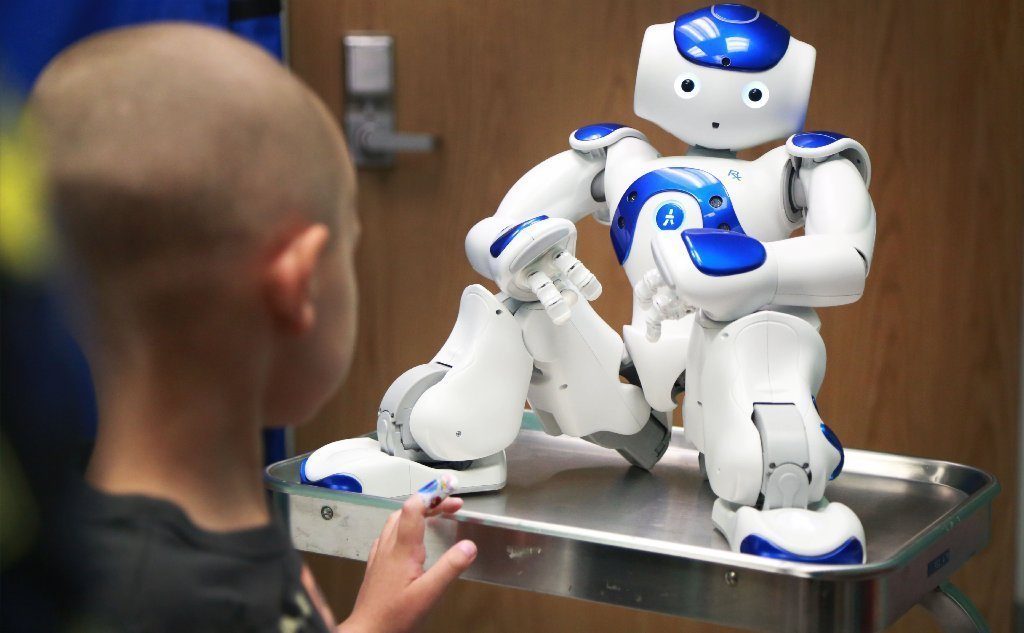
MEDi, a blue and white robot now on staff Broward Health Children’s Hospital, has just the right touch when it comes to keeping little ones calm.
In a randomized controlled trial, the robot — which has fittingly been renamed Ivey — serves two different purposes. In one use, it’s merely a distraction. Kids play a dress-up game on a tablet that has an image of Ivey on it. Depending on which outfit they choose, the robot will say a statement like, “I’m a cowboy now!”
In the other use, the tablet games are designed to mimic the things a child life specialist does to get a child ready before IV placement. One game, for example, lets kids wrap a bandage around an object to prepare them for when their own arm gets wrapped up. In another game, the child sees images of different people in their life, such as family members and doctors and even Ivey. When the child taps on an image, Ivey says something about how that person is there to support and help them.
The study is ongoing, but early data show some promising results.
“There’s certainly a positive impact of having the robot over not having the robot,” Trost said. “How much that impact is will need to be borne out by statistics and by finishing the study.”
Assistants, not replacements
Any fear about socially assistive robots taking people’s jobs is misplaced, Mataric says.
“In no way are we replacing human caregivers,” she said, noting that the robots are intended to help make up for the lack of qualified workers.
Parker can relate. Seven years ago, he watched his son Logan lie alone in a hospital bed after he’d had his kidney removed. The then-14-year-old had a rare form of kidney cancer, and there was no Boo Boo to comfort him or keep him company.
That experience inspired Parker to find a companion for kids like Logan, who’s now cancer-free.
“I figured out that this would have been a great solution for him, and I wanted it to be a good solution for other kids,” he said.
